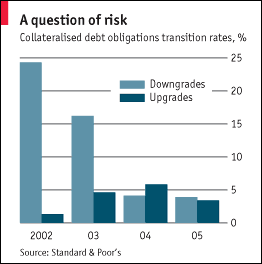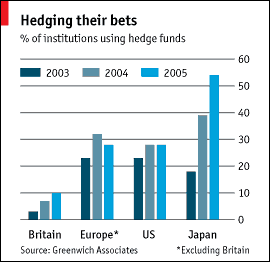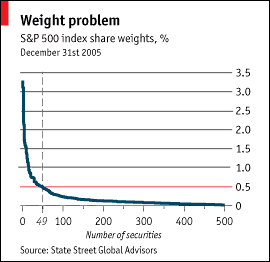FaGal
Utente Registrato
- Registrato
- 21/7/02
- Messaggi
- 17.980
- Punti reazioni
- 231
Maurizio Blondet
07/02/2006
Attenti, ingenui risparmiatori: le banche ci si stanno già truffando, perché per questi nuovi «prodotti finanziari» possono caricare commissioni più grasse che mai (1).
Presto ve li proporranno e consiglieranno: comprateli, sono meglio di Parmalat e dei bond argentini, vi diranno.
Gli ultimi OGM finanziari distillati dagli alchimisti dell'usura si chiamano «ibridi», perché sono un incrocio contro natura tra azioni e obbligazioni.
Un'impresa che debba raccogliere capitale lo può fare in due modi: indebitandosi emettendo obbligazioni, o cedendo una parte della proprietà emettendo azioni.
Emettere obbligazioni ha vari vantaggi per l'azienda: politici (perché non cede proprietà), tributari, perché essendo le obbligazioni un debito le emissioni godono di deduzioni fiscali, e di costo (l'indebitato paga al creditore un interesse fisso).
Ma una compagnia che s'indebita «troppo», diffondendo troppe obbligazioni, mina la propria reputazione come debitrice: e le agenzie di «rating» sono lì a declassare il loro debito, obbligandole a rialzare gli interessi che devono corrispondere ai creditori, detentori della loro carta.
Per questo le aziende prendono capitale un po' emettendo debito, un po' risolvendosi a vendere azioni ossia quote di proprietà.
L'emissione di azioni però è costosa, sul 12% fra tasse e altri costi.
Nell'insieme, una ditta che raccolga liquidità per 100 milioni di euro, metà in azioni e metà in obbligazioni, paga su questo mix costi attorno all'8 %.
Con gli ibridi, il costo per la compagnia è la metà: sul 4%.
Inoltre gli ibridi possono essere «scolpiti» su misura per le esigenze del debitore.
Gli ibridi consentono dunque alle aziende di indebitarsi più della misura consentita.
Da una parte, hanno i caratteri di obbligazioni (pagano qualcosa di simile ad «interessi» fissi), dall'altra hanno i vantaggi delle azioni: non vengono mai a scadenza (maturity) e non devono essere rimborsati; e i cosiddetti «interessi» possono essere, come i dividendi azionari, differiti o non pagati per anni.
In sé non sono una novità.
A certi fortunati privilegiati vengono distribuite azioni «privilegiate» appunto perché pagano un dividendo prefissato, prima che i comuni azionisti vedano un solo centesimo in dividendi.
Da un decennio la finanza creativa ha messo in circolazione certe «trust preferred securities» (Trups) che sono azioni privilegiate, ma confezionate in modo da lucrare la deducibilità fiscale per le aziende che le emettono.
Lo scopo è illusionistico, come dice il Financial Times: creare strumenti finanziari che «sembrano» un debito per chi li emette, per chi li compra e (soprattutto) al Fisco, ma che «appaiono» come azioni, ossia non come debito, alle agenzie di rating.
E infatti sono proprio le agenzie di rating ad avere insufflato una vita insperata agli ibridi.
Mesi fa Moody's, rovesciando una sua politica tradizionale, ha cominciato a considerare gli ibridi «più» come azioni e «meno» come obbligazioni, sancendo che ogni ibrido è al 75% azione e al 25% obbligazione.
Le aziende che emettono ibridi per 100 si indebitano, ai fini del rating, come se emettessero obbligazioni per 25.
E' un modo nuovo per indebitarsi eccessivamente, senza farlo sapere ai creditori.
E per evadere le tasse.
Standard & Poor's e Merrill Lynch hanno ovviamente seguito Moody's, come per ordine ricevuto dai salotti buoni dell'alta finanza in difficoltà.
Così opportunamente cambiate le regole del gioco, le banche d'affari e speculative hanno cominciato a salivare, prevedendo profitti enormi per sé.
Gli ibridi, con i loro vantaggi per i creditori, si delineano come l'affare del secolo per i banchieri che li confezioneranno su misura per le aziende, perché su queste operazioni possono chiedere («sono difficili da fare», è la scusa) un rincaro della commissione superiore all'1 %.
Per dire quanto è gigantesco l'affare, Citigroup ha calcolato con l'acquolina in bocca che se le prime 500 aziende USA sostituissero solo il 5% del loro capitale con gli ibridi, il loro «valore» (in realtà la loro capacità di indebitamento aggiuntivo) crescerebbe di 100 miliardi di dollari: un valore su cui le banche d'affari ritaglieranno le loro commissioni maggiorate.
Solo quest'anno l'emissione di ibridi ha raggiunto i 30 miliardi di dollari (erano 4 miliardi l'anno scorso), e si apprestano a soffiare il primato alle emissioni di obbligazioni-spazzatura ad alto tasso d'interesse (e ad alto rischio d'insolvenza), che è sui 90 miliardi.
In Europa la febbre degli ibridi infuria addirittura più che negli Stati Uniti.
Facile capire che questo gioco che tanto piace alla speculazione ha degli ovvi perdenti.
Il primo perdente è l'erario di tutti gli Stati, costretti ad accettare dal «nuovo legislatore globale» (Moody's & Co.) come «debito» deducibile ciò che è «azione» al 75%.
Ma i sicuri perdenti saranno i risparmiatori.
A cui queste creature sintetiche saranno presentate «sicure come obbligazioni» (si è visto com'erano sicuri i bond Parmalat e Argentina) e «lucrose come azioni» (perché gli interessi o semi-dividendi sono più alti), ma prive dei rischi del capitale di rischio.
Non si dirà al risparmiatore che questi ibridi sono, dal punto di vista legale, equiparati al «credito subordinato a lungo termine»: il che significa che se l'azienda che li ha emessi fallisce, il detentore di questi titoli «sicurissimi» starà in coda all'ultimo posto nella fila dei creditori.
E che il piccolo interesse in più corrisponde ad un rischio ignoto, essendo questi prodotti ancora sconosciuti, e il loro comportamento inesplorato, per esempio, in un clima di credito debole.
Persino il Financial Times (ma in caratteri microscopici nell'ultima pagina) ha scritto: «è difficile sfuggire alla sensazione sgradevole che questi prodotti-camaleonte abbiano in serbo alcune (amare) sorprese per gli investitori quando chi li emette affronterà difficoltà finanziarie nel mondo reale» (2).
Non dite poi che non vi avevano avvisato.
Maurizio Blondet
Note
1) Richard Beales, «Banks hope to cash in on rush into hybrid securities», Financial Times, 6 febbraio 2006.
2) «Centaurs or minotaurs», Financial Times, 6 febbraio 2006.
http://www.effedieffe.com/interventizeta.php?id=937¶metro=economia
07/02/2006
Attenti, ingenui risparmiatori: le banche ci si stanno già truffando, perché per questi nuovi «prodotti finanziari» possono caricare commissioni più grasse che mai (1).
Presto ve li proporranno e consiglieranno: comprateli, sono meglio di Parmalat e dei bond argentini, vi diranno.
Gli ultimi OGM finanziari distillati dagli alchimisti dell'usura si chiamano «ibridi», perché sono un incrocio contro natura tra azioni e obbligazioni.
Un'impresa che debba raccogliere capitale lo può fare in due modi: indebitandosi emettendo obbligazioni, o cedendo una parte della proprietà emettendo azioni.
Emettere obbligazioni ha vari vantaggi per l'azienda: politici (perché non cede proprietà), tributari, perché essendo le obbligazioni un debito le emissioni godono di deduzioni fiscali, e di costo (l'indebitato paga al creditore un interesse fisso).
Ma una compagnia che s'indebita «troppo», diffondendo troppe obbligazioni, mina la propria reputazione come debitrice: e le agenzie di «rating» sono lì a declassare il loro debito, obbligandole a rialzare gli interessi che devono corrispondere ai creditori, detentori della loro carta.
Per questo le aziende prendono capitale un po' emettendo debito, un po' risolvendosi a vendere azioni ossia quote di proprietà.
L'emissione di azioni però è costosa, sul 12% fra tasse e altri costi.
Nell'insieme, una ditta che raccolga liquidità per 100 milioni di euro, metà in azioni e metà in obbligazioni, paga su questo mix costi attorno all'8 %.
Con gli ibridi, il costo per la compagnia è la metà: sul 4%.
Inoltre gli ibridi possono essere «scolpiti» su misura per le esigenze del debitore.
Gli ibridi consentono dunque alle aziende di indebitarsi più della misura consentita.
Da una parte, hanno i caratteri di obbligazioni (pagano qualcosa di simile ad «interessi» fissi), dall'altra hanno i vantaggi delle azioni: non vengono mai a scadenza (maturity) e non devono essere rimborsati; e i cosiddetti «interessi» possono essere, come i dividendi azionari, differiti o non pagati per anni.
In sé non sono una novità.
A certi fortunati privilegiati vengono distribuite azioni «privilegiate» appunto perché pagano un dividendo prefissato, prima che i comuni azionisti vedano un solo centesimo in dividendi.
Da un decennio la finanza creativa ha messo in circolazione certe «trust preferred securities» (Trups) che sono azioni privilegiate, ma confezionate in modo da lucrare la deducibilità fiscale per le aziende che le emettono.
Lo scopo è illusionistico, come dice il Financial Times: creare strumenti finanziari che «sembrano» un debito per chi li emette, per chi li compra e (soprattutto) al Fisco, ma che «appaiono» come azioni, ossia non come debito, alle agenzie di rating.
E infatti sono proprio le agenzie di rating ad avere insufflato una vita insperata agli ibridi.
Mesi fa Moody's, rovesciando una sua politica tradizionale, ha cominciato a considerare gli ibridi «più» come azioni e «meno» come obbligazioni, sancendo che ogni ibrido è al 75% azione e al 25% obbligazione.
Le aziende che emettono ibridi per 100 si indebitano, ai fini del rating, come se emettessero obbligazioni per 25.
E' un modo nuovo per indebitarsi eccessivamente, senza farlo sapere ai creditori.
E per evadere le tasse.
Standard & Poor's e Merrill Lynch hanno ovviamente seguito Moody's, come per ordine ricevuto dai salotti buoni dell'alta finanza in difficoltà.
Così opportunamente cambiate le regole del gioco, le banche d'affari e speculative hanno cominciato a salivare, prevedendo profitti enormi per sé.
Gli ibridi, con i loro vantaggi per i creditori, si delineano come l'affare del secolo per i banchieri che li confezioneranno su misura per le aziende, perché su queste operazioni possono chiedere («sono difficili da fare», è la scusa) un rincaro della commissione superiore all'1 %.
Per dire quanto è gigantesco l'affare, Citigroup ha calcolato con l'acquolina in bocca che se le prime 500 aziende USA sostituissero solo il 5% del loro capitale con gli ibridi, il loro «valore» (in realtà la loro capacità di indebitamento aggiuntivo) crescerebbe di 100 miliardi di dollari: un valore su cui le banche d'affari ritaglieranno le loro commissioni maggiorate.
Solo quest'anno l'emissione di ibridi ha raggiunto i 30 miliardi di dollari (erano 4 miliardi l'anno scorso), e si apprestano a soffiare il primato alle emissioni di obbligazioni-spazzatura ad alto tasso d'interesse (e ad alto rischio d'insolvenza), che è sui 90 miliardi.
In Europa la febbre degli ibridi infuria addirittura più che negli Stati Uniti.
Facile capire che questo gioco che tanto piace alla speculazione ha degli ovvi perdenti.
Il primo perdente è l'erario di tutti gli Stati, costretti ad accettare dal «nuovo legislatore globale» (Moody's & Co.) come «debito» deducibile ciò che è «azione» al 75%.
Ma i sicuri perdenti saranno i risparmiatori.
A cui queste creature sintetiche saranno presentate «sicure come obbligazioni» (si è visto com'erano sicuri i bond Parmalat e Argentina) e «lucrose come azioni» (perché gli interessi o semi-dividendi sono più alti), ma prive dei rischi del capitale di rischio.
Non si dirà al risparmiatore che questi ibridi sono, dal punto di vista legale, equiparati al «credito subordinato a lungo termine»: il che significa che se l'azienda che li ha emessi fallisce, il detentore di questi titoli «sicurissimi» starà in coda all'ultimo posto nella fila dei creditori.
E che il piccolo interesse in più corrisponde ad un rischio ignoto, essendo questi prodotti ancora sconosciuti, e il loro comportamento inesplorato, per esempio, in un clima di credito debole.
Persino il Financial Times (ma in caratteri microscopici nell'ultima pagina) ha scritto: «è difficile sfuggire alla sensazione sgradevole che questi prodotti-camaleonte abbiano in serbo alcune (amare) sorprese per gli investitori quando chi li emette affronterà difficoltà finanziarie nel mondo reale» (2).
Non dite poi che non vi avevano avvisato.
Maurizio Blondet
Note
1) Richard Beales, «Banks hope to cash in on rush into hybrid securities», Financial Times, 6 febbraio 2006.
2) «Centaurs or minotaurs», Financial Times, 6 febbraio 2006.
http://www.effedieffe.com/interventizeta.php?id=937¶metro=economia

 La settimana è stata all’insegna degli acquisti per i principali listini internazionali. Gli indici americani S&P 500, Nasdaq e Dow Jones hanno aggiornato i massimi storici dopo i dati americani sui prezzi al consumo di mercoledì, che hanno evidenziato una discesa in linea con le aspettative, con l’inflazione headline al 3,4% e l’indice al 3,6% annuo, allentando i timori per un’inflazione persistente. Anche le vendite al dettaglio Usa sono rimaste invariate su base mensile, suggerendo un raffreddamento dei consumi che hanno fin qui sostenuto i prezzi. Questi dati, dunque, rafforzano complessivamente le possibilità di un taglio dei tassi a settembre da parte della Fed (le scommesse del mercato sono ora per due tagli nel 2024). Per continuare a leggere visita il
La settimana è stata all’insegna degli acquisti per i principali listini internazionali. Gli indici americani S&P 500, Nasdaq e Dow Jones hanno aggiornato i massimi storici dopo i dati americani sui prezzi al consumo di mercoledì, che hanno evidenziato una discesa in linea con le aspettative, con l’inflazione headline al 3,4% e l’indice al 3,6% annuo, allentando i timori per un’inflazione persistente. Anche le vendite al dettaglio Usa sono rimaste invariate su base mensile, suggerendo un raffreddamento dei consumi che hanno fin qui sostenuto i prezzi. Questi dati, dunque, rafforzano complessivamente le possibilità di un taglio dei tassi a settembre da parte della Fed (le scommesse del mercato sono ora per due tagli nel 2024). Per continuare a leggere visita il 



 interdittivi...come la pensiamo diversamente...
interdittivi...come la pensiamo diversamente...